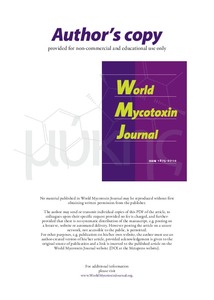| dc.contributor.author | Williams, W.P. |
| dc.contributor.author | Krakowsky, M.D. |
| dc.contributor.author | Scully, B.T. |
| dc.contributor.author | Brown, R.L. |
| dc.contributor.author | Menkir, A. |
| dc.contributor.author | Warburton, M.L. |
| dc.contributor.author | Windham, G.L. |
| dc.date.accessioned | 2019-12-04T10:58:10Z |
| dc.date.available | 2019-12-04T10:58:10Z |
| dc.date.issued | 2015 |
| dc.identifier.citation | Williams, W.P., Krakowsky, M.D., Scully, B.T., Brown, R.L., Menkir, A., Warburton, M.L., & Windham, G.L. (2014). Identifying and developing maize germplasm with resistance to accumulation of aflatoxins. World Mycotoxin Journal, 8(2), 193-209. |
| dc.identifier.issn | 1875-0710 |
| dc.identifier.uri | https://hdl.handle.net/20.500.12478/931 |
| dc.description | Special Issue: aflatoxins in and other crops |
| dc.description.abstract | Efforts to identify maize germplasm with resistance to
Aspergillus flavus
infection and subsequent accumulation
of aflatoxins were initiated by the US Department of Agriculture, Agricultural Research Service at several locations
in the late 1970s and early 1980s. Research units at four locations in the south-eastern USA are currently engaged
in identification and development of maize germplasm with resistance to
A. flavus
infection and accumulation of
aflatoxins. The Corn Host Plant Resistance Research Unit, Mississippi State, MS, developed procedures for screening
germplasm for resistance to
A. flavus
infection and accumulation of aflatoxins. Mp313E, released in 1990, was the
first line released as a source of resistance to
A. flavus
infection. Subsequently, germplasm lines Mp420, Mp715,
Mp717, Mp718, and Mp719 were released as additional sources of resistance. Quantitative trait loci associated with
resistance have also been identified in four bi-parental populations. The Crop Protection and Management Research
Unit and Crop Genetics and Breeding Research Unit, Tifton, GA, created a breeding population GT-MAS:gk. GT601,
GT602, and GT603 were developed from GT-MAS:gk. The Food and Feed Safety Research Unit, New Orleans, LA,
in collaboration with the International Institute for Tropical Agriculture used a kernel screening assay to screen
germplasm and develop six germplasm lines with resistance to aflatoxins. The Plant Science Research Unit, Raleigh,
NC, through the Germplasm Enhancement of Maize (GEM) Project provides to co-operators diverse germplasm
that is a valuable source of resistance to
A. flavus
infection and accumulation of aflatoxins in maize |
| dc.language.iso | en |
| dc.subject | Aflatoxins |
| dc.subject | Aspergillus Flavus |
| dc.subject | Maize |
| dc.title | Identifying and developing maize germplasm with resistance to accumulation of aflatoxins |
| dc.type | Journal Article |
| dc.description.version | Peer Review |
| cg.contributor.crp | Maize |
| cg.contributor.affiliation | United States Department of Agriculture |
| cg.contributor.affiliation | North Carolina State University |
| cg.contributor.affiliation | International Institute of Tropical Agriculture |
| cg.coverage.region | Africa |
| cg.coverage.region | West Africa |
| cg.coverage.country | Nigeria |
| cg.isijournal | ISI Journal |
| cg.authorship.types | CGIAR and advanced research institutes |
| cg.iitasubject | Aflatoxin |
| cg.iitasubject | Maize |
| cg.journal | World Mycotoxin Journal |
| cg.howpublished | Formally Published |
| cg.accessibilitystatus | Limited Access |
| local.dspaceid | 76430 |
| cg.identifier.doi | https://dx.doi.org/10.3920/WMJ2014.1751 |

